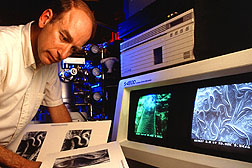This page has been archived and is being provided for reference purposes only. The page is no longer being updated, and therefore, links on the page may be invalid.
|
Read the magazine story to find out more.. |
|
|
|
|
Roundworm Repository Contributes to Agricultural Wellbeing
By Jan SuszkiwJanuary 4, 2010
Agricultural Research Service (ARS) scientists in Beltsville, Md., manage a most unusual sort of insurance: 43,000 slides and vials containing all manner of wormlike organisms called nematodes, from the costliest pest of soybeans, Heterodera glycines, to bacteria-feeding species with potential use in biological insect control.
The collection, known as the USDA Nematode Collection, is among the largest repositories of its kind, according to David Chitwood, who leads the ARS Nematology Laboratory in Beltsville. There, six scientists and support staff maintain the collection for systematic studies, taxonomic classifications and training purposes. They also provide expert species identification for regulatory agencies tasked with helping safeguard U.S. agriculture, such as USDA’s Animal and Plant Health Inspection Service (APHIS).
Nematode identification requests come often. In 2008, ARS microbiologist Zafar Handoo identified nearly 700 samples, including nearly 300 sent by APHIS personnel at ports of entry or from domestic surveys.
One of the more high-profile cases occurred in 2000, when laboratory researchers met with a visiting Brazilian delegation in response to a ban Brazil had imposed on U.S. wheat exports for fear of introducing the seed gall nematode, Anguina tritici.
A turning point came when the researchers discovered a single slide of a specimen that a port inspector had submitted in 1953. A database search of information on the collection revealed the genus (Anguina), and the host plant from which the specimen had been isolated (reedgrass). The search also revealed that the country of origin was actually Brazil, which subsequently lifted its ban, reopening a $50-200 million annual market for U.S. wheat.
According to Chitwood, the market could have remained closed had it not been for that one slide, illustrating the collection’s importance to U.S. agriculture and trade.
Distinguishing one nematode species from another is no easy feat, considering many have similar-looking mouthparts, tail tips and other identifying characteristics. Read more about the research in the January 2010 issue of Agricultural Research magazine.
ARS is the principal intramural scientific research agency of the U.S. Department of Agriculture. The research supports the USDA priority of promoting international food security.

